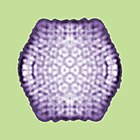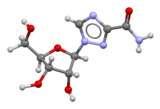Portal:Viruses
The Viruses Portal
Welcome!

Viruses are small infectious agents that can replicate only inside the living cells of an organism. Viruses infect all forms of life, including animals, plants, fungi, bacteria and archaea. They are found in almost every ecosystem on Earth and are the most abundant type of biological entity, with millions of different types, although only about 6,000 viruses have been described in detail. Some viruses cause disease in humans, and others are responsible for economically important diseases of livestock and crops.
Virus particles (known as virions) consist of genetic material, which can be either DNA or RNA, wrapped in a protein coat called the capsid; some viruses also have an outer lipid envelope. The capsid can take simple helical or icosahedral forms, or more complex structures. The average virus is about 1/100 the size of the average bacterium, and most are too small to be seen directly with an optical microscope.
The origins of viruses are unclear: some may have evolved from plasmids, others from bacteria. Viruses are sometimes considered to be a life form, because they carry genetic material, reproduce and evolve through natural selection. However they lack key characteristics (such as cell structure) that are generally considered necessary to count as life. Because they possess some but not all such qualities, viruses have been described as "organisms at the edge of life".
Selected disease

Meningitis is an acute inflammation of the meninges, protective membranes covering the brain and spinal cord. Symptoms in adults include headache, fever and neck stiffness, as well as sometimes confusion or altered consciousness, vomiting, and an inability to tolerate light or loud noises. Children often show only nonspecific symptoms, such as irritability or drowsiness.
The most common cause is infection with viruses including enteroviruses, herpes simplex virus (mainly HSV-2), varicella zoster virus, mumps virus, HIV and lymphocytic choriomeningitis. In Western countries, viral meningitis occurs in around 11 people per 100,000 each year. Infection with bacteria, fungi, protozoa and parasites can also cause meningitis, and there are several non-infectious causes. Although some forms of meningitis can be life-threatening, viral meningitis is generally more benign than that caused by bacterial infection. It usually resolves spontaneously and is rarely fatal. HSV-2 can cause a chronic, recurrent form called Mollaret's meningitis.
Polymerase chain reaction of cerebrospinal fluid and identification of antibodies can be used to differentiate between viral causes. Viral meningitis typically only requires supportive therapy; meningitis caused by HSV or varicella zoster virus sometimes responds to treatment with antiviral drugs such as aciclovir. Mumps-associated meningitis can be prevented by vaccination.
Selected image
Bacteriophages, viruses that infect bacteria, are among the most common entities on Earth.
Credit: Graham Beards (21 October 2008)
In the news
26 February: In the ongoing pandemic of severe acute respiratory syndrome coronavirus 2 (SARS-CoV-2), more than 110 million confirmed cases, including 2.5 million deaths, have been documented globally since the outbreak began in December 2019. WHO
18 February: Seven asymptomatic cases of avian influenza A subtype H5N8, the first documented H5N8 cases in humans, are reported in Astrakhan Oblast, Russia, after more than 100,0000 hens died on a poultry farm in December. WHO
14 February: Seven cases of Ebola virus disease are reported in Gouécké, south-east Guinea. WHO
7 February: A case of Ebola virus disease is detected in North Kivu Province of the Democratic Republic of the Congo. WHO
4 February: An outbreak of Rift Valley fever is ongoing in Kenya, with 32 human cases, including 11 deaths, since the outbreak started in November. WHO
21 November: The US Food and Drug Administration (FDA) gives emergency-use authorisation to casirivimab/imdevimab, a combination monoclonal antibody (mAb) therapy for non-hospitalised people twelve years and over with mild-to-moderate COVID-19, after granting emergency-use authorisation to the single mAb bamlanivimab earlier in the month. FDA 1, 2
18 November: The outbreak of Ebola virus disease in Équateur Province, Democratic Republic of the Congo, which started in June, has been declared over; a total of 130 cases were recorded, with 55 deaths. UN
Selected article
Plant viruses face different challenges from animal viruses. As plants do not move, transmission between hosts often involves vectors, most commonly insects, but also nematodes and protozoa. Plant viruses can also spread via seeds, and by direct transfer of sap. Plant cells are surrounded by cell walls which are difficult to penetrate. Movement between cells occurs mainly by transport through plasmodesmata, and most plant viruses encode movement proteins to make this possible. Although plants lack an adaptive immune system, they have complex defences against viral infection. Viruses of cultivated plants often cause disease, and are thought to cause up to US$60 billion losses to global crop yields each year; infections of wild plants are often asymptomatic.
Most plant viruses are rod-shaped, with protein discs forming a tube surrounding the viral genome; isometric particles are another common structure. They rarely have an envelope. The great majority have an RNA genome, which is usually small and single stranded. Plant viruses are grouped into 73 genera and 49 families. Tobacco mosaic virus (pictured) is among the best characterised of the 977 species officially recognised in 1999.
Selected outbreak
The 2009 flu pandemic was an influenza pandemic first recognised in Mexico City in March 2009 and declared over in August 2010. It involved a novel strain of H1N1 influenza virus with genes from five different viruses, which resulted when a previous triple reassortment of avian, swine and human influenza viruses further combined with a Eurasian swine influenza virus, leading to the term "swine flu" being used for the pandemic. It was the second pandemic to involve an H1N1 strain, the first being the 1918 "Spanish flu" pandemic.
The global infection rate was estimated as 11–21%. This pandemic strain was less lethal than previous ones, killing about 0.01–0.03% of those infected, compared with 2–3% for Spanish flu. Most experts agree that at least 284,500 people died, mainly in Africa and Southeast Asia – comparable with the normal seasonal influenza fatalities of 290,000–650,000 – leading to claims that the World Health Organization had exaggerated the danger.
Selected quotation
| “ | ...classical approaches to classification are not suitable for viruses, as rigid hierarchies cannot be imposed on organisms that appear – evolutionarily speaking – to have been rather promiscuous in sharing their characteristics around. | ” |
—Ed Rybicki
Recommended articles
Viruses & Subviral agents: bat virome • elephant endotheliotropic herpesvirus • HIV • introduction to viruses![]() • Playa de Oro virus • poliovirus • prion • rotavirus
• Playa de Oro virus • poliovirus • prion • rotavirus![]() • virus
• virus![]()
Diseases: colony collapse disorder • common cold • croup • dengue fever![]() • gastroenteritis • Guillain–Barré syndrome • hepatitis B • hepatitis C • hepatitis E • herpes simplex • HIV/AIDS • influenza
• gastroenteritis • Guillain–Barré syndrome • hepatitis B • hepatitis C • hepatitis E • herpes simplex • HIV/AIDS • influenza![]() • meningitis
• meningitis![]() • myxomatosis • polio
• myxomatosis • polio![]() • pneumonia • shingles • smallpox
• pneumonia • shingles • smallpox
Epidemiology & Interventions: 2007 Bernard Matthews H5N1 outbreak • Coalition for Epidemic Preparedness Innovations • Disease X • 2009 flu pandemic • HIV/AIDS in Malawi • polio vaccine • Spanish flu • West African Ebola virus epidemic
Virus–Host interactions: antibody • host • immune system![]() • parasitism • RNA interference
• parasitism • RNA interference![]()
Methodology: metagenomics
Social & Media: And the Band Played On • Contagion • "Flu Season" • Frank's Cock![]() • Race Against Time: Searching for Hope in AIDS-Ravaged Africa
• Race Against Time: Searching for Hope in AIDS-Ravaged Africa![]() • social history of viruses
• social history of viruses![]() • "Steve Burdick" • "The Time Is Now" • "What Lies Below"
• "Steve Burdick" • "The Time Is Now" • "What Lies Below"
People: Brownie Mary • Macfarlane Burnet![]() • Bobbi Campbell • Aniru Conteh • people with hepatitis C
• Bobbi Campbell • Aniru Conteh • people with hepatitis C![]() • HIV-positive people
• HIV-positive people![]() • Bette Korber • Henrietta Lacks • Linda Laubenstein • Barbara McClintock
• Bette Korber • Henrietta Lacks • Linda Laubenstein • Barbara McClintock![]() • poliomyelitis survivors
• poliomyelitis survivors![]() • Joseph Sonnabend • Eli Todd • Ryan White
• Joseph Sonnabend • Eli Todd • Ryan White![]()
Selected virus
Sputnik virophage is a subviral agent, discovered in 2008, that infects Acanthamoeba protozoa. It is a satellite virus of giant viruses of the Mimiviridae family. It requires a mimivirus to infect the cell simultaneously to replicate, hijacking the virus factories that mimivirus creates and impairing its replication. Sputnik was the first satellite to be shown to inhibit the replication of its associated helper virus. Such viruses have been termed "virophages" or "virus eaters" – by analogy with bacteriophages, viruses that parasitise bacteria – but the distinction between virophages and classical satellite viruses that infect plants, arthropods and mammals is disputed. Three Sputnik types are now known, and other virophages have since been discovered, now classified in the Lavidaviridae family, including the Zamilon, Mavirus and Organic Lake virophages. All virophages that have been characterised infect protists and all rely on nucleocytoplasmic large DNA viruses as helpers.
Sputnik's non-enveloped icosahedral capsid is 74 nm in diameter, and contains a circular double-stranded DNA genome of 18.3 kb. Three of its 21 predicted protein-coding genes are thought to derive from Acanthamoeba polyphaga mimivirus, suggesting that virophages and giant viruses can swap genes during their joint infection of Acanthamoeba, and also that virophages might mediate horizontal gene transfer between giant viruses.
Did you know?
- ...that modified mRNA (mRNA translation depicted) is a key technology in the Moderna and BioNTech/Pfizer vaccines against COVID-19?
- ...that Derrick Tovey recognised early cases of smallpox during an outbreak in Bradford in 1962?
- ...that Nkosi's Haven is a South African care centre created to address HIV-related discrimination, including the separation of infected mothers from their children?
- ...that American physician Max C. Starkloff used social distancing to fight the 1918 flu pandemic in St. Louis?
- ...that following his research for Epidemiology in Country Practice, William Pickles observed that "studies in epidemiology sometimes reveal romances"?
Selected biography
Frederick Sanger (13 August 1918 – 19 November 2013) was a British biochemist, the only person to have been awarded the Nobel Prize for Chemistry twice.
He started to research nucleic acid sequencing in the early 1960s. In 1975, he co-invented the "Plus and Minus" technique for sequencing DNA, which could sequence 80 nucleotides at once, a significant improvement on earlier techniques. Using this method, his group sequenced most of the 5,386 nucleotides of φX174 bacteriophage – the first virus and the first DNA genome to be completely sequenced – and showed that some of its genes overlapped. In 1977, he and his group pioneered the Sanger (or dideoxy chain-termination) method for sequencing DNA and used it to sequence the 48,502 bp bacteriophage λ. His technique remained the most widely used sequencing method until the mid-2000s, and was used to generate the first human genome sequence. Sanger is also known for sequencing bovine insulin, the first protein to be sequenced. The Sanger Institute was named for him.
In this month
May 1955: First issue of Virology; first English-language journal dedicated to virology
4 May 1984: HTLV-III, later HIV, identified as the cause of AIDS by Robert Gallo and coworkers
5 May 1939: First electron micrographs of tobacco mosaic virus taken by Helmut Ruska and coworkers
5 May 1983: Structure of influenza neuraminidase solved by Jose Varghese, Graeme Laver and Peter Colman
8 May 1980: WHO announced formally the global eradication of smallpox
11 May 1978: SV40 sequenced by Walter Fiers and coworkers
12 May 1972: Gene for bacteriophage MS2 coat protein is sequenced by Walter Fiers and coworkers, the first gene to be completely sequenced
13 May 2011: Boceprevir approved for the treatment of chronic hepatitis C virus (HCV) infection, the first direct-acting antiviral for HCV
14 May 1796: Edward Jenner inoculated James Phipps (pictured) with cowpox
15/16 May 1969: Death of Robert Rayford, the earliest confirmed case of AIDS outside Africa
18 May 1998: First World AIDS Vaccine Day
20 May 1983: Isolation of the retrovirus LAV, later HIV, by Luc Montagnier, Françoise Barré-Sinoussi and coworkers
23 May 2011: Telaprevir approved for the treatment of chronic HCV infection
25 May 2011: WHO declared rinderpest eradicated
31 May 1937: First results in humans from the 17D vaccine for yellow fever published by Max Theiler and Hugh H. Smith
Selected intervention
Ribavirin is a nucleoside analogue that mimics the nucleoside guanosine. It shows some activity against a broad range of DNA and RNA viruses, but is less effective against dengue fever, yellow fever and other flaviviruses. The drug was first synthesised in the early 1970s by Joseph T. Witkowski and Roland K. Robins. Ribavirin's main current use is against hepatitis C, in combination with pegylated interferon, nucleotide analogues and protease inhibitors. It has been used in the past in an aerosol formulation against respiratory syncytial virus-related diseases in children. Ribavirin has been used in combination as part of an experimental treatment for rabies. It is also the only available treatment for the viruses causing some viral haemorrhagic fevers, including Lassa fever, Crimean–Congo haemorrhagic fever and hantavirus disease, but is ineffective against the filovirus diseases, Ebola and Marburg. Clinical use is limited by the drug building up in red blood cells to cause haemolytic anaemia.
Subcategories
Subcategories of virology:
Topics
Things to do
- Comment on what you like and dislike about this portal
- Join the Viruses WikiProject
- Tag articles on viruses and virology with the project banner by adding {{WikiProject Viruses}} to the talk page
- Assess unassessed articles against the project standards
- Create requested pages: red-linked viruses | red-linked virus genera
- Expand a virus stub into a full article, adding images, citations, references and taxoboxes, following the project guidelines
- Create a new article (or expand an old one 5-fold) and nominate it for the main page Did You Know? section
- Improve a B-class article and nominate it for Good Article
 or Featured Article
or Featured Article status
status - Suggest articles, pictures, interesting facts, events and news to be featured here on the portal
WikiProjects & Portals
 WikiProject Viruses
Related WikiProjects
WikiProject Viruses
Related WikiProjects
Medicine • Microbiology • Molecular & Cellular Biology • Veterinary Medicine
Related PortalsAssociated Wikimedia
The following Wikimedia Foundation sister projects provide more on this subject:
-
Commons
Free media repository -
Wikibooks
Free textbooks and manuals -
Wikidata
Free knowledge base -
Wikinews
Free-content news -
Wikiquote
Collection of quotations -
Wikisource
Free-content library -
Wikispecies
Directory of species -
Wikiversity
Free learning tools -
Wiktionary
Dictionary and thesaurus


















